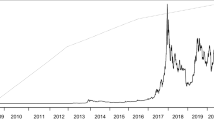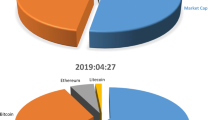Abstract
The convenience yield differential between on- and off-the-run Treasury securities with identical maturities has two components. A non-cyclical component may arise due to the higher illiquidity of off-the-run bonds. Also, trading in the market for the next issue often causes cyclical shortages of the on-the-runs. When this occurs, owners of the on-the-run bond can earn riskless profits by borrowing at a special repo rate while lending at the prevailing risk free market rate. This second component of the convenience yield, induced by the auction, is cyclical. We first show that special repo rates and the convenience yield are jointly cyclical over the auction cycle. The patterns are statistically significant and pervasive. Repo specials are highest around the announcement day and disappear by the issue day. The off- minus on-the-run yield spread is highest at the beginning of the cycle and collapses near its end, consistent with a decreasing present value of profits over a decreasing horizon. Second, we develop a first no-arbitrage continuous-time model, with both interest and special repo rates stochastic, that prices the on-the-run bonds that command this convenience yield. A simple implementation of the model can generate yields consistent with the evidence.
Similar content being viewed by others
References
Brennan, M. and E. Schwartz. (1985). “Evaluating Natural Resource Investment,” Journal of Business 58, 135-157.
Cammack, E. (1991). “Evidence on Bidding Strategies and the Information in Treasury Bill Auctions,” Journal of Political Economy 99, 100-130.
Chatterjea, A. and R. Jarrow. (1998). “Market Manipulation, Price Bubbles, and a Model of the United States Treasury Securities Auction Market,” Journal of Financial and Quantitative Analysis 33(2).
Cherian, J., E. Jacquier, R. Jarrow, and H. Ma. (1997). “Pricing the Convenience Yield in Treasury Securities: Theory and Evidence,” Working Paper, Boston University.
Cherian, J., E. Jacquier, and R. Jarrow. (2002). “Convenience Yields in On-the-Run Treasuries: Theory and Evidence,” Working Paper, Boston College.
Cherian, J. and R. Jarrow. (1995). “Market Manipulation.” In R. Jarrow, V. Maksimovic, and W. Ziemba (eds.) Finance: Handbooks in Operations Research and Management Science, Vol. 9, Chapter 20. Amsterdam: North Holland, pp. 611-630.
Cornell, B. and A. Shapiro. (1989). “The Mispricing of US Treasury Bonds: A Case Study,” The Review of Financial Studies 2, 297-310.
Corrigan, D., C. Georgiou, and J. Gollow. (2000). Repo The Ultimate Guide. London, UK: Pearls of Wisdom Publishing.
Duffee, G. (1996). “Idiosyncratic Variations of Treasury Bills,” Journal of Finance 51, 527-551.
Duffie, D. (1996a). “Special Repo Rates,” Journal of Finance 51, 493-526.
Duffie, D. (1996b). Dynamic Asset Pricing Theory. Princeton, NJ: Princeton University Press.
Duffie, D., C. Skiadas, and M. Schroder. (1996). “Recursive Valuation of Defaultable Securities and the Timing of the Resolution of Uncertainty,” Annals of Applied Probability 6, 1075-1090.
Fisher, M. and C. Gilles. (1996). “The Term Structure of Repo Spreads,” Working Paper, Board of Governors Federal Reserve System.
Fleming, M. (2000). “Financial Implications of the Federal Debt Paydown,” Brookings Papers on Economic Activity 2, 221-251.
Gibson, R. and E.S. Schwartz. (1990). “Stochastic Convenience Yield and the Pricing of Oil Contingent Claims,” Journal of Finance 45, 959-976.
Grinblatt, M. (2001). “An Analytic Solution for Interest Rate Swap Spreads,” International Review of International Finance 2(3), 113-149.
Grinblatt, M. and F. Longstaff. (2000). “Financial Innovation and the Role of Derivative Securities: An Analysis of the Treasury STRIPS Program,” Journal of Finance 55(3), 1415-1436.
Harrison, J. and D. Kreps. (1979). “Martingales and Arbitrage in Multiperiod Securities Markets,” Journal of Economic Theory 20, 391-408.
Heath, D., R. Jarrow, and A. Morton. (1992). “Bond Pricing and the Term Structure of Interest Rates,” Econometrica 60, 77-105.
Hull, J. (2000). Options, Futures, and Other Derivative Securities, 4th ed. Englewood Cliffs, NJ: Prentice Hall.
Hull, J. and A. White. (1990). “Pricing Interest Rate Derivative Securities,” The Review of Financial Studies 3, 573-592.
Hull, J. and A. White. (1994). “Numerical Procedures for Implementing Term Structure Models I: Single Factor Models,” Journal of Derivatives 2, 7-16.
Hull, J. and A. White. (1996). “Using Hull-White Interest Rate Trees,” Journal of Derivatives, 26-36.
Jarrow, R. and S. Turnbull. (1997). “An Integrated Approach to the Hedging and Pricing of Eurodollar Derivatives,” Journal of Risk and Insurance 64(2), 481-523.
Jegadeesh, S. (1993). “Treasury Auction Bids and the Salomon Squeeze,” Journal of Finance 48(4), 1403-1419.
Jordan, B. and S. Jordan. (1997). “An Empirical Investigation of the Repo Special Rate,” Journal of Finance 52, 2051-2072.
Keane, F. (1996). “Repo Rate Patterns for New Treasury Notes,” New York Fed Newsletter: Current Issues in Economics and Finance 2(10), 2-6.
Krishnamurty, A. (2001). “The Bond/Old-Bond Spread,” Kellogg Working Paper, Northwestern.
Lowenstein, R. (2000). The Rise and Fall of Long-Term Capital Management. New York: Random House.
Malvey, P.F. and C.M. Archibald. (1998). “Uniform-Price Auctions: Update of the Treasury Experience,” U.S. Treasury Domestic Finance Report.
Short S. and I. Schneider. (1994). “Repo/Securities Lending,” Euromoney, 81-84.
Stigum, M. (1989). The Repo and Reverse Markets. Homewood, IL: Dow Jones-Irwin Publishers.
Sundaresan, S. (1994). “An Empirical Analysis of U.S. Treasury Auctions: Implications for Auction and Term Structure Theories,” Journal of Fixed Income 4, 35-50.
Vasicek, O. (1977). “An Equilibrium Characterization of the Term Structure,” Journal of Financial Economics 5, 177-188.
Warga, A. (1992). “Bond Returns, Liquidity, and Missing Data,” Journal of Financial and Quantitative Analysis 27, 605-617.
Author information
Authors and Affiliations
Rights and permissions
About this article
Cite this article
Cherian, J.A., Jacquier, E. & Jarrow, R.A. A Model of the Convenience Yields in On-the-Run Treasuries. Review of Derivatives Research 7, 79–97 (2004). https://doi.org/10.1023/B:REDR.0000031174.07795.51
Issue Date:
DOI: https://doi.org/10.1023/B:REDR.0000031174.07795.51




